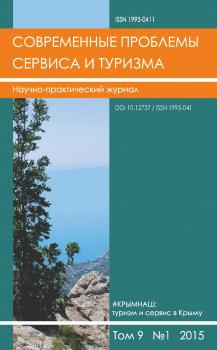The article is devoted to the study of the possibilities and peculiarities of the city environment from the point of view of providing the necessary conditions for the active city lifestyle and active tourism. Cities are interested in the develop- ment of tourism, as an industry that actively attracts investments in the economy, creating a huge variety of workplaces and selfemployment, contributing to the growth of the tax base, preserving local uniqueness and historical and cultural heritage that stimulates creative industries. Obviously, it is impossible, and it is not necessary to create two different cities – “for tourists” and “for citizens”. It means that infrastructure, including transport, street network, cafes and restaurants, entertainment and shopping centers, parks and embankments are actively used by both citizens and tourists. Moreover tourists are attracted by the same objects and events that are in demand among local residents. Accordingly, the creation of a comfortable, safe, friendly city environment is a prerequisite for development, both in terms of improving the quality of life of citizens and attracting tourists. Cities are interested in diversifying the offer for tourist and should contribute to the formation of material and unmaterial factors for the active tourism development. Material factors include the corresponding infrastructure, high-quality ecological situation and a number of others. Unmaterial factors are formed on the basis of city culture, one of the values of which is the active way of life. Priority should be given to the development of the infrastructure of safe school routes, stimulating active modes of movement in the daily regime, creating accessible and safe areas for various sports and outdoor activities.
city, urban areas, active tourism, city tourism, agglomeration tourism, safe school route
1. Baksheev V.I., Kolomoec N.M. Dnevnik pacienta s arterial'noy gipertenziey. M.: OOO «Insayt-Poligrafik», 2005. 72 s.
2. Glazychev V.L., Egorov M.M., Il'ina T.V. i dr. Gorodskaya sreda. Tehnologiya razvitiya: Nastol'- naya kniga. M.: Izd-vo «Lad'ya», 1995. 240 s.
3. Trutnev E.K., Bandorin L.E., Gudz' T.V. i dr. Gradoregulirovanie: Osnovy regulirovaniya gradostroitel'noy deyatel'nosti v usloviyah stanovleniya rynka nedvizhimosti. M.: Fond «Institut ekonomiki goroda», 2008. 296 s.
4. Lappo G.M. Geografiya gorodov. M.: VLADOS, 1997. 480 s.
5. Zakirova Yu.A. Formirovanie modeley-prototipov obschestvennyh peshehodnyh prostranstv // Izvestiya KGASU. 2012. №3. S. 27-31.
6. Zakirova Yu.A., Husnutdinova S.R., Kasimova A.R. Metodika partisipativnogo proektirovaniya gorodskoy sredy v sovremennom rossiyskom gradostroitel'stve // Izvestiya KGASU. 2016. №1(35). S. 81-86.
7. Zakirova Yu.A., Husnutdinova S.R., Yurinova A.O. Formirovanie funkcional'no-prostranstvennoy modeli aglomeracionnogo poyasa g. Kazan' // Izvestiya KGASU. 2016. №1(35). S. 87-94.
8. Rozanova L.N., Muhametova L.R. Sovremennyy turistskiy klaster Respubliki Tatarstan // So- vremennye problemy servisa i turizma. 2016. T.10. №1. S. 67-74. DOI:https://doi.org/10.12737/17785.
9. Sluka N.A. Gradocentricheskaya model' mirovogo hozyaystva. M.: Press-Solo, 2005. 168 s.
10. Smolyar I.M. Gradostroitel'noe planirovanie kak sistema: prognozirovanie - programmirovanie - proektirovanie. M.: RAASN, 2001.
11. Husnutdinova S.R. Vystavki kak meropriyatiya sobytiynogo turizma i ih rol' v social'no-eko- nomicheskom razvitii goroda // Sovremennye problemy nauki i obrazovaniya. 2012. №3. URL: http://www.science-education.ru/ru/article/view?id=6214 (data obrascheniya: 04.06.2017).
12. Husnutdinova S.R., Safonova M.V. Nematerial'noe nasledie kak social'nyy faktor razvitiya urbanizirovannyh territoriy v usloviyah servisnoy ekonomiki // Sovremennye problemy servisa i turizma. 2016. T.10. №3. S. 18-25. DOI:https://doi.org/10.12737/21094.
13. Husnutdinova S.R. Primenenie mental'nyh kart dlya izucheniya vospriyatiya gorozhanami social'no-ekologicheskih aspektov urbanizirovannyh territoriy // Ekologicheskiy konsalting. 2016. №3(63). S. 17-21.
14. Husnutdinova S.R., Dembich A.A., Zakirova Yu.A. Social'no-ekologicheskie faktory formirovaniya komfortnoy sredy urbanizirovannyh territoriy // Geograficheskiy vestnik. 2016. №4(39). S. 28-35. DOI:https://doi.org/10.17072/2079-7877-2016-4-28-35.
15. Day C. Places of the Soul: Architecture and Environmental Design as Healing Art. Architectural Press, 2010
16. Gehl J. Cities for People. Island Press, 2010.
17. Hinch T., Holt N. Sustaining places and participatory sport tourism events // Journal of Sustainable Tourism. 2017. Vol.25. Iss.8. Pr. 1084-1099. DOI:https://doi.org/10.1080/09669582.2016.1253703.
18. Hodeck A., Hovemann G. Motivation of active sport tourist in a German highland destination - a cross-seasonal comparision // Journal of Sport and Tourism. 2016. Vol.20, Iss.3-4. Pr. 335-348. DOI: 1 0.1080/14775085.2016.1235988.
19. Lynch K. The Image of the City. Cambridge, MA: MIT Press, 1960.
20. Sassen S. The global city: introducing a concept // Brown Journal of World Affairs. 2005. Vol.11. Iss. 2. Pp. 27-43.
21. Tomik R., Kosmala G., Ardenska A. Active sport tourism in Poland: environmental condition and mo- tivational aspect // European Journal of Geography. 2017. Vol. 8. Iss. 1. Pp. 129-138





